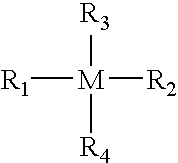Process for improved coupling of rubbery polymers
- Summary
- Abstract
- Description
- Claims
- Application Information
AI Technical Summary
Benefits of technology
Problems solved by technology
Method used
Image
Examples
example 1
In this experiment, a tin coupled styrene-butadiene rubber was prepared at 70° C. In the procedure used, 2300 g of a silica / alumina / molcular sieve dried premix containing 19.5 weight percent styrene / 1,3-butadiene mixture in hexanes was charged into a one-gallon (3.8 liters) reactor. The ratio of styrene to 1,3-butadiene was 15:85. After the amount of impurity in the premix was determined, 2.4 ml of 1 M solution of TMEDA (N, N, N′, N′-tetramethylethylene-diamine in hexanes), 1.5 ml of 1 M solution of lithium t-butoxide (in hexanes) and 2.92 ml. of 1.03M solution of n-butyllithium (in hexanes) were added to the reactor. The target Mn (number averaged molecular weight) was 150,000. The polymerization was allowed to proceed at 70° C. for 1.5 hours. The GC analysis of the residual monomers contained in the polymerization mixture indicated that most of the monomers were converted to polymer. After a small aliquot of polymer cement was removed from the reactor (for analysis), 1.2 ml. of a...
example 2
The procedure described in Example 1 was utilized in this example except that lithium t-butoxide solution was added to the polymerization mixture when all the monomers were consumed (90 minutes after initiation) and prior to adding the coupling agent. The Tg and microstructure of the resulting coupled SBR are shown in Table 1. The Mooney viscosities of the base and coupled polymers are also shown in Table 1. The coupling efficiency was 81%, based on GPC measurement.
example 4
The tin coupled SBR prepared in this experiment was synthesized in a three-reactor (1 gallon, 2 gallon, 2 gallon) continuous system at 80° C. A premix containing styrene and 1,3-butadiene in hexanes was charged into the first polymerization reactor continuously at a rate of 98 grams per minute. The premix monomer solution containing a ratio of styrene to 1,3-butadiene of 18:82 and had a total monomer concentration of 16%. Polymerization was initiated by adding n-butyl lithium (0.6 mmole / 100 grams of monomer), TMEDA (1 mmole / 100 grams monomer) and lithium mentholate (0.5 mmole / 100 grams monomer) to the first reactor continuously. The resulting polymerization medium containing the live ends was continuously pushed to the second rector (for completing the polymerization) and then the third reactor where the coupling agent, tin tetrachloride, (0.15 mmole / 100 grams monomer) was added continuously. The residence time for all reactors was set at one hour to achieve complete monomer conver...
PUM
| Property | Measurement | Unit |
|---|---|---|
| Fraction | aaaaa | aaaaa |
| Percent by mass | aaaaa | aaaaa |
| Percent by mass | aaaaa | aaaaa |
Abstract
Description
Claims
Application Information
 Login to View More
Login to View More - R&D
- Intellectual Property
- Life Sciences
- Materials
- Tech Scout
- Unparalleled Data Quality
- Higher Quality Content
- 60% Fewer Hallucinations
Browse by: Latest US Patents, China's latest patents, Technical Efficacy Thesaurus, Application Domain, Technology Topic, Popular Technical Reports.
© 2025 PatSnap. All rights reserved.Legal|Privacy policy|Modern Slavery Act Transparency Statement|Sitemap|About US| Contact US: help@patsnap.com


